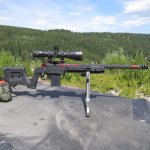I have been doing some work on 783s, and am quite impressed with them. I would not suggest that they are approaching a limited production precision action, but I do think they represent excellent value, and would work very well for a new shooter, particularly one who has not made the decision to get really serious about a particular discipline. The Tikkas are certainly holding their own. Investing in coaching, ammunition and range time might be more beneficial to a new competitor than buying a high end custom rifle.
The scope is where it makes the most sense to buy quality from the get go. Going cheap on the optic is poor economy.
The scope is where it makes the most sense to buy quality from the get go. Going cheap on the optic is poor economy.








































































